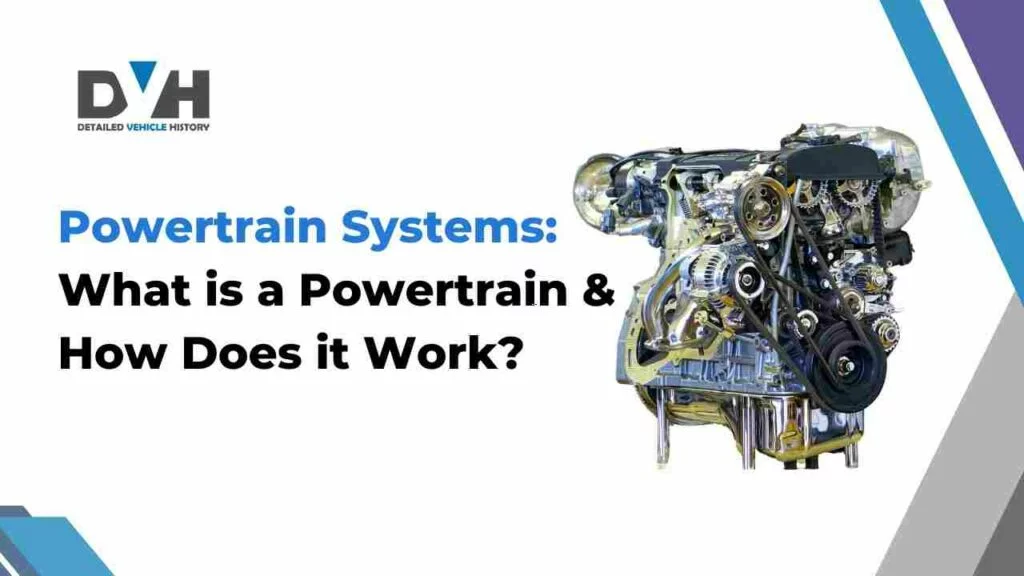When discussing cars, you’ll often hear the term “powertrain.” But what is it, exactly? Simply put, a car’s powertrain is a group of components that generate power and deliver it to the wheels. It’s the beating heart of your vehicle, responsible for making it move efficiently.
Understanding the powertrain system is more than a technical curiosity for car owners. It’s essential knowledge, especially when buying a used car. If you want to understand your car’s powertrain in detail, try the VIN Decoder tool on detailedvehiclehistory.com. This tool reveals specific information about your vehicle’s components and history.
Table of Contents
- How Does a Powertrain Work?
- How Does a Powertrain System Affect Vehicle Performance?
- Difference Between a Powertrain and Drivetrain
- Types of Drivetrains
- Front-Wheel Drive
- Rear-Wheel Drive
- All-Wheel Drive
- Four-Wheel Drive
- Signs Your Powertrain Might Be Wearing Out
- Powertrain Frequently Asked Questions
How Does a Powertrain Work?
A powertrain system combines several critical components. The engine produces power, which the transmission modifies to suit driving conditions. The driveshaft transfers this power to the wheels, and the differential adjusts wheel speeds during turns.
Each component plays a unique role. For example, the engine’s timing and condition significantly affect performance. Curious about your engine’s specifics?
Related: Find out more about the types of your car engine.
How Does a Powertrain System Affect Vehicle Performance?
The powertrain system heavily influences your car’s capabilities. A robust powertrain improves acceleration, enabling quicker response times when merging or overtaking. It also determines towing capacity, which matters for hauling heavy loads.
Fuel efficiency is another critical factor. Modern powertrains balance performance with fuel economy, giving drivers the best of both worlds. If you’re experiencing fuel efficiency issues, improper timing could be a culprit.
Related: Learn how to tell if the timing is off on an engine.
Difference Between a Powertrain and Drivetrain
Though the terms are similar, they are not interchangeable. The powertrain includes the engine, transmission, and components that generate and transfer power. The drivetrain excludes the engine, focusing solely on components that transfer power to the wheels.
Understanding this distinction can help when discussing vehicle warranties. Many warranties specify coverage for either the powertrain or the drivetrain. To decode your warranty terms, visit the warranty by VIN.
Types of Drivetrains
Drivetrains determine how a vehicle distributes power to its wheels. Let’s break down the main types:
Front-wheel drive (FWD)
In FWD systems, power goes to the front wheels. This setup is efficient and popular in many sedans and compact cars. It improves fuel economy and provides better traction in light snow or rain.
Rear-wheel drive (RWD)
RWD vehicles send power to the rear wheels. This design offers better weight distribution, enhancing handling and acceleration. Sports cars and trucks often use RWD for these reasons.
All-wheel drive (AWD)
AWD systems distribute power to all four wheels as needed. They excel in providing stability and traction on slippery roads. If you’re driving in variable weather, AWD ensures consistent performance.
Four-wheel drive (4WD)
4WD systems, designed for off-road adventures, engage all wheels equally for superior grip. They’re common in trucks and SUVs built for rugged terrain.
Signs Your Powertrain Might Be Wearing Out
A failing powertrain shows warning signs that shouldn’t be ignored. Listen for clunking or whining noises from the engine or transmission. You might also notice sluggish acceleration or difficulty shifting gears.
Poor fuel efficiency can also indicate powertrain trouble. If you’ve accidentally used the wrong fuel type, it could cause significant damage. Learn what happens if you put diesel gas in a car to avoid costly mistakes.
Early detection is critical to preventing severe issues. Look for warning lights and address concerns immediately.
Powertrain Frequently Asked Questions
What are maintenance tips for powertrain longevity?
Regular oil changes, timely transmission fluid replacements, and careful driving habits extend the life of your powertrain. Also, inspect the engine and belts periodically to ensure they are in good condition.
What are some common issues with powertrain systems?
Common problems include faulty transmissions, worn-out driveshafts, and engine misfires. If you’re buying a used car, always verify its mileage. Learn how to verify the mileage on a used car engine to avoid surprises.
Does the powertrain affect fuel efficiency?
Yes, a well-maintained powertrain ensures optimal fuel usage. Issues like a worn-out timing belt or transmission problems reduce efficiency.
For a detailed overview of your car’s original features and history, check out the window sticker lookup tool. It’s a quick way to learn more about your vehicle’s design and specifications.
Understanding your car’s powertrain isn’t just for enthusiasts. It’s essential for good decisions, especially when buying or maintaining a vehicle.










